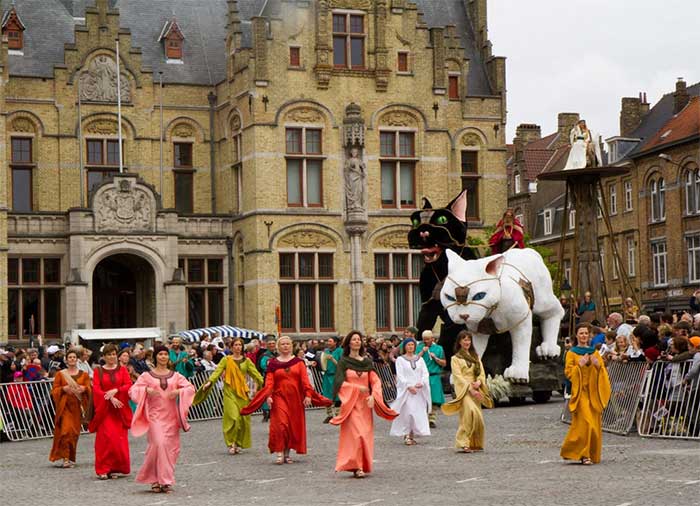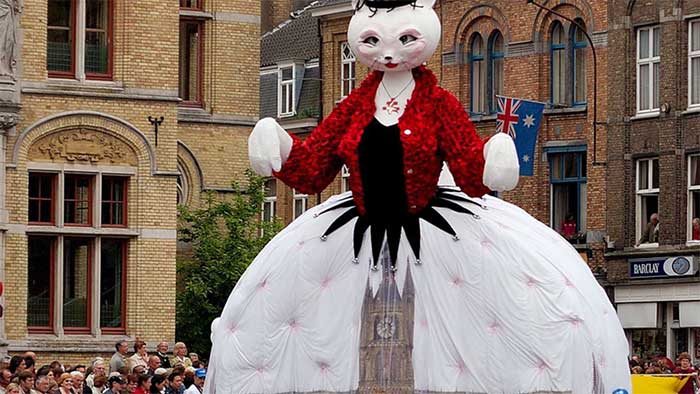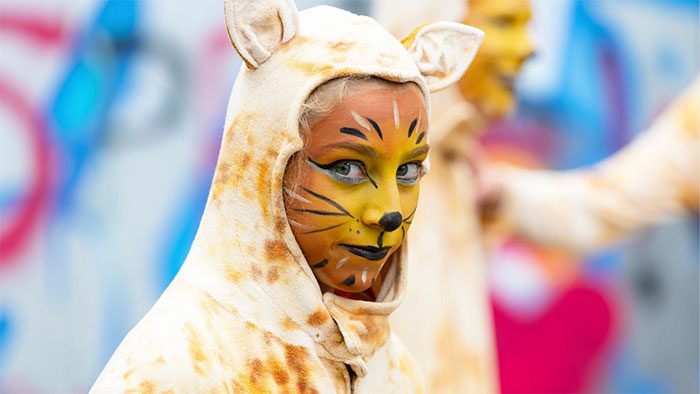The Kattenstoet Festival (meaning “Festival of Cats”) is an annual event in Ypres, Belgium, where locals throw cats from the rooftops of buildings. This festival is held to celebrate the founding of the city and was first organized in 1066.
Dressed as playful cats and parading alongside magnificently decorated floats, thousands of people immerse themselves in the vibrant atmosphere as they march to the Cloth Hall – the hub of the thriving textile industry in Ypres, Belgium.
From the top of this building, they throw stuffed cats down below. This marks the opening of the Kattenstoet Festival – the Festival of Cats.

A lively performance at the Kattenstoet Festival. (Photo: rove.me).
For the past 67 years, Ypres has become a tourist destination with its unique Kattenstoet Festival. Literally, Kattenstoet means “the parade of cats”
and it is the oldest cat festival in Belgium. The festival is held every three years on the second Sunday of May. With such a unique origin, Kattenstoet has turned into a festive occasion enjoyed not only by cat lovers in Ypres but also attracting visitors from all around the world.
A Colorful Parade

The giant cat Minneke Poes participating in the Kattenstoet parade. (Photo: Wikimedia Commons).
The most prominent feature of the parade is the giant cat effigy, also known as “the cat of Ypres”. Alongside this, the parade features around 2,000 participants dressed as cats, mice, witches, cartoon characters, and fairy tale figures.
The floats are also decorated with a cat theme, reflecting local legends and the city’s history. Immersed in the lively sounds of brass bands and spectacular performances by dancers, the parade moves through the town’s streets amidst the enthusiastic cheers of the crowd.
After passing through the town, the participants of the festival begin to head towards the Cloth Hall. Some locals throw stuffed cats from the bell tower of the building down below. In the square, the crowd scrambles to “catch” the cats thrown from the windows. Those who catch the stuffed cats are considered very lucky. They are allowed to make a wish, even if it is unrelated to cats.
Following the throwing of the stuffed cats, the “witch burning” ceremony takes place. Festival attendees burn a witch effigy to ward off bad luck and evil spirits. The festival then continues with concerts and other lively performances around the town.
The first cat parade was held in Ypres in 1938. Initially, it was just a small event, but it has now grown into a major national festival. While the exact origins of the parade are unclear, many legends suggest that this tradition dates back to the Middle Ages.
The History of Kattenstoet

Festival attendees dressed as cats at the Kattenstoet. (Photo: Condé Nast).
Although it is a fun festival, Kattenstoet has a rather grim origin. In medieval Europe, cats were seen as unlucky creatures associated with the devil. Historical records from that time even compared the act of cats catching mice to demonic traps set for human souls. In the early 14th century, Pope Gregory IX called for action against rituals closely associated with cats. Many believe this was the reason for the mass extermination of cats across Europe.
In fact, the Pope’s decree came at a time when many people believed that cats were connected to the wave of the plague, also known as the “Black Death” in the 14th century. This epidemic was transmitted to humans by fleas infesting rats. The mass killing of cats in Europe led to an exponential rise in the rat population, which allowed the plague to spread rapidly.
While the hypothesis linking cats to the plague seems rather tenuous, it did not diminish the cruelty inflicted upon these animals in Europe at the time. The belief that cats represented evil led to their mistreatment, and millions of these creatures were killed. In Ypres, people held annual celebrations of Kattenstoet. At that time, they would throw cats from the top of the bell tower at the Cloth Hall down to the town square below. Some believed that this ritual could destroy evil spirits and help the city prosper.
Other theories suggest that cats were brought to the Cloth Hall, one of the largest trading buildings at the time, to prevent rats from destroying imported wool and valuable clothing. In the Middle Ages, Ypres, like many towns in the Flanders region of Belgium, was famous for its textile industry. Skilled artisans often imported wool from England and wove it into expensive garments. The fabrics and clothing were stored in the warehouses of the Cloth Hall, which attracted rats that gnawed and caused dangerous diseases.
To prevent the rodents from destroying the warehouses, the fabric merchants in Ypres brought cats to the site. However, the cats bred rapidly, surpassing the city’s ability to control them. The number of cats grew so large that townspeople were forced to throw the animals out of the local bell tower. Over time, the act of throwing cats became a ritual in Ypres, known as “Cat Wednesday.”
This barbaric practice continued until 1817 when the last surviving cat was thrown and escaped. From then until World War I, “Cat Wednesday” was simply observed by ringing the church bells.
In 1938, the festival was symbolically revived when a group of local youth organized a cat parade. They brought a stuffed cat to the church and held a party there. Later, one of the youths climbed the bell tower and threw the stuffed cat down to the ground. It wasn’t until 1955 that the city began hosting the first large-scale parade, grandly decorated floats, and thousands of participants in costumes. Perhaps today’s cat festival serves as one of the ways to remember the dark history of Kattenstoet.


















































